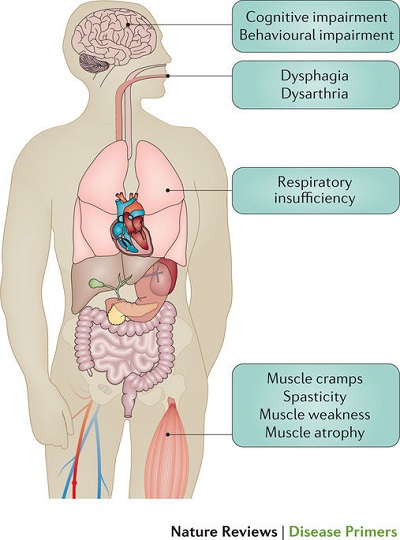筋萎縮性側索硬化症
Amyotrophic lateral sclerosis
2017年10月5日 Nature Reviews Disease Primers Article number: 17071 (2017) doi: 10.1038/nrdp.2017.71

筋萎縮性側索硬化症(ALS、別名:運動ニューロン障害)は、上位および下位運動ニューロンの変性を特徴とし、筋力低下を経て、最終的には麻痺に至る疾患である。ALSは最近まで、主に神経筋そのものの障害と分類されていたが、新しいイメージング技術と神経病理学的所見から、疾患病理学上、非運動脳脊髄幹の障害であることが明らかにされた。ALSの発症機構は大多数の患者でほとんど解明されていないが、一部の患者では家族性疾患の場合や、神経機能にさまざまな役割を担う遺伝子の変異があることが確認されている。ALSの進行を遅延できる疾患修飾療法として、現在、2つの方法が検討されているが、大多数の患者の管理では、痙攣に対する筋弛緩薬投与や、構音障害に対する言語療法などの対症療法が行われる。
PrimeView
筋萎縮性側索硬化症(ALS)の症状には、上位運動ニューロンおよび下位運動ニューロンの障害による兆候が含まれる。このPrimeView では、HardimanらのPrimerの内容にそって、主にALSの症状や診断精密検査について取りまとめる。
本Primerの図解サマリー
Amyotrophic lateral sclerosis (ALS), also known as motor neuron disease, is characterized by the degeneration of both upper and lower motor neurons, which leads to muscle weakness and eventual paralysis. Until recently, ALS was classified primarily within the neuromuscular domain, although new imaging and neuropathological data have indicated the involvement of the non-motor neuraxis in disease pathology. In most patients, the mechanisms underlying the development of ALS are poorly understood, although a subset of patients have familial disease and harbour mutations in genes that have various roles in neuronal function. Two possible disease-modifying therapies that can slow disease progression are available for ALS, but patient management is largely mediated by symptomatic therapies, such as the use of muscle relaxants for spasticity and speech therapy for dysarthria.

